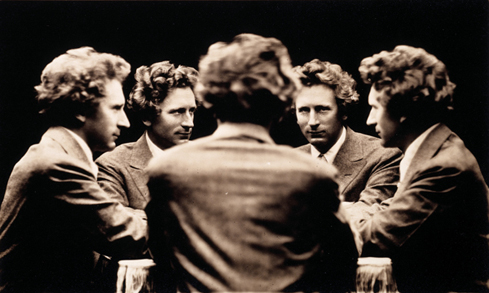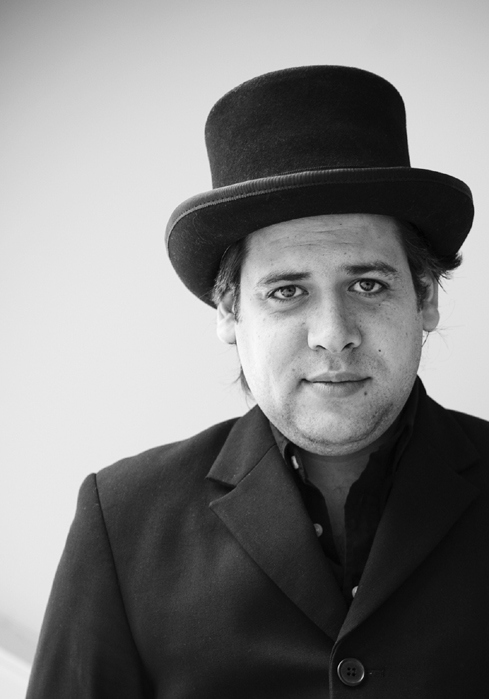Sonic mirages, robotics, subsonic mania and creating situations to expand sonic perception is the name of the game for experimental composer James Hullick. Doubling as a new music entrepeneur, Hullick’s set up Sono Perception, an event taking place at Canberra’s National Film and Sound Archive on Wednesday, June 18, and Carriageworks Sydney on Friday, June 20.
You’ve been described as a young wild one of the new sound scene. But ironically, you might be the first person in the sonic art scene in Australia since Percy Grainger to get about in a suit and tie.
I know! How rebellious!
Can you tell us about Jolt Arts?
Jolt is a sonic and visual arts organisation, it’s not just about the sound experience. There’ no such thing as a purely auditory experience. There was a really great experiment done by a guy called John Oswald, who did concerts in pitch black and then used special cameras to take photos of the audience, and they were all in these weird contorted positions and shapes because noone could see them, they’d lost a sense of themselves. Something is causing a jolt it is the mind, rather than just the purely entertainment experience of sound. So I’ve tried to put this show together to hopefully shed some light on some interesting aspect of music making, or visual art.
Jolt presents Sono Perception in Canberra as part of the National Film and Sound Archive’ Sound Day, which celebrates the cultural significance, art and history of recorded sound in Australia. How do you see Jolt’s relationship to this prestigious event?
I think for us it’s a very important for Jolt to be at Sound Day, because I don’ see the National Film and Sound Archive as a house of documentation. I see it as a fluid interactive entity. Particularly for those people working with sound recordings and sound archiving. They’re passionate about sound and that stimulates thought and ideas for me. With this particular show, I made sure we had some Percy Grainger stuff, and that was something we discussed right at the start with the NFSA. Percy Grainger is a really important figure, because he works across some really diverse and conflicting mediums and ideas. He”s like a pop star with some of his pieces – then he’ got this really experimental side where he was exploring the sounds of machines at a very early time. It’s really important that in Australia, this electronic investigation into music was going on quite early in the scheme of things in an international context and I think that empowers the National Film and Sound Archive, because we have these artists here in Australia – well there’ a lot to do! – and how do we represent these figures to the wider Australian community?
In the late ’30s, Australian composers Burnett Cross and Percy Grainger built electro-acoustic machines they called Free Music Machines. They used radio frequency oscillators or Theremins that created sound from vocal interaction. You’ve lined up electro-acoustic musician Warren Burt and composer Catherine Schieve to perform a new composition for Cross and Grainger’ Electric Eye Tone Tool. Can you tell us about the original Eye Tone Tool and how Schieve and Burt have re-interpreted it?
The actual sound that comes out does bear a relationship to the sound Percy Grainger made but it’s somehow evolved or moved in another direction. Catherine Schieve has done a five meter score, which is actually scanned over the Electric Eye Tone Tool – that is how the tool was originally used – and that Eye Tone Tool pumps out sine waves of a similar timbre to what Percy Grainger had planned. But what he didn’ plan was that the score would be moved as an acted performance over the scanning bed. Standing at either end of The Eye Tone Tool, Warren and Catherine move the score as a slightly choreographed performance, and that generates the outcome of the piece so it’s like a composition that’s been notated but is then improvised with as a visual element that generates improvised sound.
Being a Melbourne based company, why curate work for the Sydney contemporary arts venue Carriageworks?
There’ a lot within that question. Firstly, I find the architecture of the Carriageworks space very inspiring. The vaulted ceilings of the industrial tram factory or railway factory, and sheds, fit perfectly with my Australian Gothic tendencies. One of the things I’m really interested in is the spirit of industry or the residue of industry. In a way, Australia’ industry is kind of corroding in terms of factories, we’re producing less, so that type of industry is vanishing, but the spaces are still there, and the memories and the lives that were formed in those spaces still exist. So for me, that’s why the Carriageworks is important.
Would it be fair to say that Sono Perception is a series of examinations by Australian sound artists on the relationship between sound and the senses?
Definitely. It’s about examining sound and perception, but it’s also about celebrating the unexplained elements of it. For example, with the Jim Tenney Piece, ‘Having Never Written A Note For Percussion’, the percussionist (Jeremy Barnett, Speak Percussion) plays one note on a gong that crescendos and de-crescendos over a 15 minute period. The overtones of the gong are actually quite complex and so you get a very complex listening experience, even though the musician who is triggering the sound is actually doing a very simple thing, it’s like an illusion. There’ an unexplained chaotic element to that that I think is really important.
We’ve talked about your work as a curator, but as an artist, can you tell us more about your Australian Gothic tendencies and your special fascination for robotic sound machines.
Those things are deeply linked I reckon, and it’s only in the past year or so that I’ve been able to start drawing the connections. I started working with robotic sculptures or just sound sculptures about three years ago. The thing with the machines is that I like to try and create them in such a way that they have such a strong visual presence that helps to reinforce the ideas within the sonic outcome. Gothic for me is about old and new technologies. Rather than technology being some great hero and enlightening us, it is often an unknown quantity. The thing that gothic aesthetic does is it asks: If this old technology works, then why don’ we use it? So this is what the automated violins are about in this particular show. I call them the ‘gotholins’, and essentially, the violin is treated as a colonial symbol, that is industrialised with these mechanical arms, and the sonic output is squeaky sounds, that suggest something of the residue of a colonial violin and sort of try and bring out the spirit of the violin. Maybe when no one is around, maybe it doesn’ want to play Bach all the time, maybe it wants to play skreaky, scratchy sounds. I’m anamorphasising the instrument a bit and that is also a part of the gothic aesthetic – that things have a spirit.

Bruce Mowson has been doing some fascinating work exploring the phenomenology and psychology of acoustic perception, will he be continuing his explorations into subconscious states of perception – which occur when people become absorbed in seeing and hearing objects in space or as you said before, when audiences lose a sense of themselves?
Bruce is really big on this word absorption and it’s a really hard concept to nail down. It’s when the audience loses their idea of self, because they’re experiencing a piece of artwork. So it’s really about just being in the sensory experience and to that with what he’ presenting. “Melting Moments’ in the Sono Perception show, basically, his strategy for that is to actually have two senses responding to the same sort of structural process, which is generated by computer, so vision and sound and in a way what he’ doing, is he’ colonising the person’ sensory experience.
For Bruce, it’s about psychological immersion. He’ working with sound and colour. The images that the audience sees are like colour field images, where the colours are slowly changing and he’ using sine tones in the sound, and their constantly shifting pitch and the colour change is actually do with the sound frequency – what pitch they’re at. So he’ exploring the gradient of colour and matching that to the gradient of pitch. But he’ working with a monochromatic sound source.
You’ve got Wyana Etherington of Speak Percussion performing on a merimba. What’s a merimba?
It looks like a xylophone, but it’s made of wood and the merimba she’ performing on is a four-octave merimba, which is a really big merimba, at least two meters long. There’ve been a lot of really great Australian percussion pieces written for merimba and it’s part of the post-1950s zeitgeist of experimental music looking at different timbres and qualities that are outside of the classical context. So that’s one of the instruments that emerged out of that era. She’ playing an arrangement that she’ done for Percy Grainger’ “Shepard’ Hay’. The reason for that is to present one of Percy Grainger’ pop tunes in relation to the Free Music Machine and actually hear how different those two things really are and how diverse his voice is. Wyana will also be playing the James Tenney piece on a Tam Tam.
Why have you chosen James Tenney’ composition to perform?
He is a guru of Sono Perception as a concept. I spent a month studying intensively with him in California, and living with him and his family, about a year before he died. There’s something I wanted to get across to an audience: music is not just about ideas, it’s also about people. Art that has the perceptual experience as the subject matter can be quite a clinical experience and that can be a weakness. But for me living with Jim, I was able to see music and art as a fluid part of culture and of his life and his relationships with his wife and kids and those sorts of things and for me then it started making a lot more sense that creating music is about this human endeavour of trying to understand who we are and how we work, and do other people experience the world in a similar way to us or do they have a very different experience. Does my friend see the same shade of green that I see? I think James Tenney was on a search for things that we accept but that we don’ necessarily question in the world.




